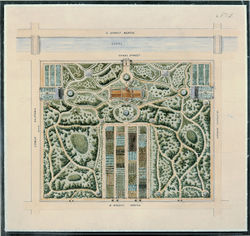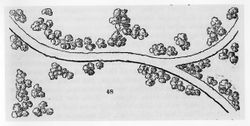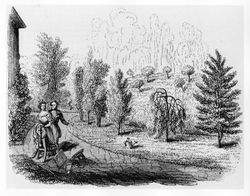Gardenesque
Definition
Two different uses of the term gardenesque have appeared in American garden writing. First, it was used as an adjective to describe architecture or ornament that seemed particularly suited for the garden. The pseudonymous critic, Horticola, provided a telling example of the term’s early usage when in 1852 he derided the appearance of a house and its grounds as being “ungardenesque,” meaning it lacked the refinement of garden improvement. J. C. Loudon, when describing Lemon Hill in Philadelphia, characterized a gardenesque structure simply as one that enhances a garden scene. Later in an 1850 essay on the waterworks at the gardens of Versailles and Château de Saint-Cloud in France, the term was still used generally to describe decorative garden fountains.
Second, gardenesque was the name of a specific design style. In an 1832 issue of his Gardener’s Magazine, Loudon used the term initially to refer to the new style that arose purely from the art of landscape gardening.[1] In his Encyclopaedia of Gardening (1834) he provided a definition that initially appeared vague but, in fact, was quite profound and charted a new theoretical course for the art of landscape design. He wrote that “the aim of the Gardenesque is to add, to the acknowledged claims of the Repton school, all those which the science of gardening and botany, in their present advanced state, are capable of producing.”[2] This seemingly simple statement represented a radical break from the predominant aesthetic preference for the natural style or picturesque beauty that had been defined in terms of the imitation of nature. The new style, in contrast, was measured in terms of its difference from the natural, unimproved appearance of the environment. Its goal was the display of the art of the garden.
Loudon defined the gardenesque as a style or mode of laying out a garden, whether in a regular or irregular design, with the intent of producing a “distinctive . . .character.” It was a style that was contrasted with the picturesque, in which clumps of trees and grouping of shrubs as found in nature had been the principle planting types. Also, it was distinct from the geometric or ancient style that often was highly architectonic and repetitious. The ultimate expression of the primary characteristic of the gardenesque was achieved by its emphasis on the unique quality of each plant specimen. Trees and shrubs were planted so that each stood alone in order to promote the fullest display of each individual specimen, as illustrated in Loudon’s Suburban Gardener, and Villa Companion (1838). Because Loudon recommended the use of colorful exotic plants, the new style was linked to horticultural knowledge and skill of the gardener-designer. The term “gardenesque,” however, was immediately misconstrued to mean a style of laying out gardens with an overly horticultural emphasis that became associated with the extreme artifice of bedding-out.[3]
A. J. Downing introduced Loudon’s theory of the gardenesque style in America in his first edition of A Treatise on the Theory and Practice of Landscape Gardening (1841), in which he reprinted two pages from Loudon’s Suburban Gardener, and Villa Companion.[4] He continued to promote the use of exotic plants in order to achieve the distinction of art for landscape design and so that gardening would not simply be seen as an imitation of nature. Downing did not, however, consider the gardenesque style superior to the picturesque or to the beautiful styles (see Picturesque). The gardenesque was most appropriate, according to both Loudon and Downing, for the design of botanic gardens and arboreta. Although he did not use the term “gardenesque” in his report, Downing employed the gardenesque style when he planned a “public museum of trees,” for the national Mall. Trees were to be “planted singly or in open groups, to allow full expansion” and viewing of specimen trees. Downing’s plan to introduce to the capital a variety of new plants that were drawn from across the newly transcontinental United States could be most effectively designed using the gardenesque mode. Although Downing’s gardenesque was based upon the highest standard of botanical expertise, he never carried it to the extreme of bedding-out and artifice that some did.
-- Therese O'Malley
- ↑ See also A. A. Tait, “Loudon and the Return to Formality,” in John Claudius Loudon and the Early Nineteenth Century in Great Britain, ed. Elisabeth Blair MacDougall (Washington, D.C.: Dumbarton Oaks, Trustees for Harvard University, 1980), 61–76.
- ↑ Ibid., 62.
- ↑ T.H.D. Turner, “Loudon’s Stylistic Development,” Journal of Garden History 2 (April–June 1982): 184. Robert Mills’s 1841 design for botanic gardens on the national Mall in Washington, D.C., exemplifies this approach [Fig. 1].
- ↑ Judith Major, To Live in a New World: A. J. Downing and American Landscape Gardening (Cambridge, Mass.: MIT Press, 1997), 58, 61.


